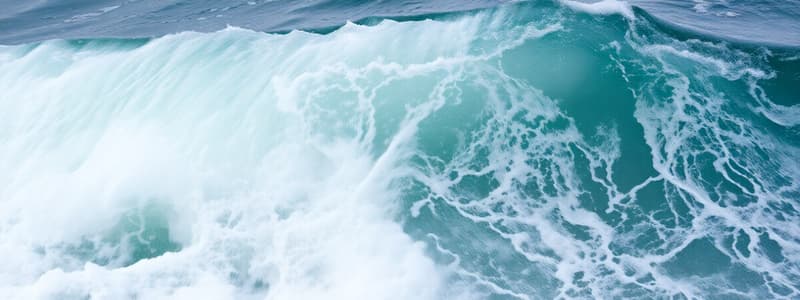Podcast
Questions and Answers
How does energy transfer through a medium in wave motion relate to density changes?
How does energy transfer through a medium in wave motion relate to density changes?
- Maximum amplitude corresponds to regions of maximum density (compression). (correct)
- Amplitude is unrelated to density changes in the medium.
- Minimum amplitude corresponds to regions of maximum density (compression).
- Maximum amplitude corresponds to regions of minimum density (rarefaction).
Why can sound waves not travel through a vacuum?
Why can sound waves not travel through a vacuum?
- Sound waves have infinitely small wavelengths.
- Sound waves are electromagnetic waves and require a medium to propagate.
- Sound waves are compression waves that rely on the mechanical action of molecules. (correct)
- Sound waves are transverse waves and require a medium to propagate.
Which of the following is a key difference between light waves and sound waves?
Which of the following is a key difference between light waves and sound waves?
- Light waves can travel through a vacuum, while sound waves cannot. (correct)
- Light waves require a medium to travel, while sound waves do not.
- Light waves transfer through the mechanical action of molecules.
- Light waves are mechanical waves, while sound waves are electromagnetic waves.
A wave bends around the edge of an obstacle. Which wave property explains this phenomenon?
A wave bends around the edge of an obstacle. Which wave property explains this phenomenon?
A scientist observes that two identical sine waves with the same frequency are perfectly overlaid, resulting in a wave with double the amplitude. Which phenomenon is the scientist observing?
A scientist observes that two identical sine waves with the same frequency are perfectly overlaid, resulting in a wave with double the amplitude. Which phenomenon is the scientist observing?
In the context of wave interference, what distinguishes a node from an antinode in a standing wave?
In the context of wave interference, what distinguishes a node from an antinode in a standing wave?
How are standing waves formed, and what role do fundamental and harmonic waves play in their creation?
How are standing waves formed, and what role do fundamental and harmonic waves play in their creation?
What causes the phenomenon of beats when two guitar strings are tuned to nearly the same frequency?
What causes the phenomenon of beats when two guitar strings are tuned to nearly the same frequency?
If a sound wave's intensity is increased, what is the effect on its intensity level (IL) measured in decibels?
If a sound wave's intensity is increased, what is the effect on its intensity level (IL) measured in decibels?
How does the presence of harmonics affect the quality or timbre of a sound?
How does the presence of harmonics affect the quality or timbre of a sound?
Flashcards
Wave Motion
Wave Motion
Energy transferred by a periodic disturbance in an elastic medium.
Compression and Rarefaction
Compression and Rarefaction
Regions of maximum and minimum density in wave motion.
Properties of Waves
Properties of Waves
Waves have amplitude, wavelength, frequency, and period.
Sound Waves
Sound Waves
Signup and view all the flashcards
Standing Waves
Standing Waves
Signup and view all the flashcards
Resultant Wave
Resultant Wave
Signup and view all the flashcards
Node
Node
Signup and view all the flashcards
Antinode
Antinode
Signup and view all the flashcards
Beat Frequency
Beat Frequency
Signup and view all the flashcards
Intensity Level (IL)
Intensity Level (IL)
Signup and view all the flashcards
Study Notes
Wave Motion and Sound
- Waves transfer energy through periodic disturbances in an elastic medium
- Compression is the region of maximum density
- Rarefaction is the region of minimum density
- Sound waves are compression waves using mechanical action of molecules
- Sound waves cannot travel through a vacuum
- Light waves are electromagnetic radiation, detectable by the human eye
- Light waves are not mechanical waves, and can travel through a vacuum
- All waves have amplitude, wavelength, frequency, and period
Properties of Waves
- Amplitude: Distance between crest (maximum displacement) and trough (minimum displacement)
- Wavelength (λ): Distance between two consecutive crests or troughs
- Frequency (f): Number of wavelengths passing a point per second (measured in Hertz)
- Period (T): Time taken for one complete wavelength to pass a point (measured in seconds)
- V = fλ (Speed = frequency x wavelength)
Reflection and Refraction
- Waves change direction when their speed changes (refraction)
- Waves reflect when encountering a solid barrier
Diffraction
- Waves "bend" around obstacles, creating a new system if an obstacle has an edge
- Diffraction explains hearing around corners
- Experiments demonstrate light's diffraction
Interference (Superposition)
- When waves converge, their effects are added algebraically
- Identical waves with same amplitude and frequency add to produce a wave of same frequency but double the amplitude
- Waves with opposing half-phase cancel each other
Standing Waves
- Standing wave forms when a wave interferes with its own reflection
- Happens when a medium is secured at both ends (e.g., guitar string)
- Result is a combination of the individual waves (interfering waves)
- Node: Point with no amplitude
- Antinode: Point of maximum amplitude
Beats
- Two almost equal frequency waves create a rise and fall in volume
- Resulting in a fixed frequency called the beat frequency due to interference patterns (constructive and destructive)
Sound
- Sound waves are pressure waves
- Humans can hear frequencies from 20 Hz to 20,000 Hz
- Intensity: Determined by amplitude, usually measured in Watts per metre²
- Intensity Level: Measured in decibels (dB)
- "Threshold of pain" is 120 dB
- Quality (timbre): Depends on the harmonics present (multiples of the fundamental frequency)
Speed of Sound
- Sound waves travel through elastic mediums (like air)
- Speed varies with atmospheric temperature
- Shock wave is created when an object travels at the speed of sound, disturbances pile up
- Sonic boom: Loud sound caused by a shock wave
Doppler Effect
- Frequency of sound changes when the source is moving
- Sound becomes higher pitch as the source approaches and lower as it moves away
Studying That Suits You
Use AI to generate personalized quizzes and flashcards to suit your learning preferences.




